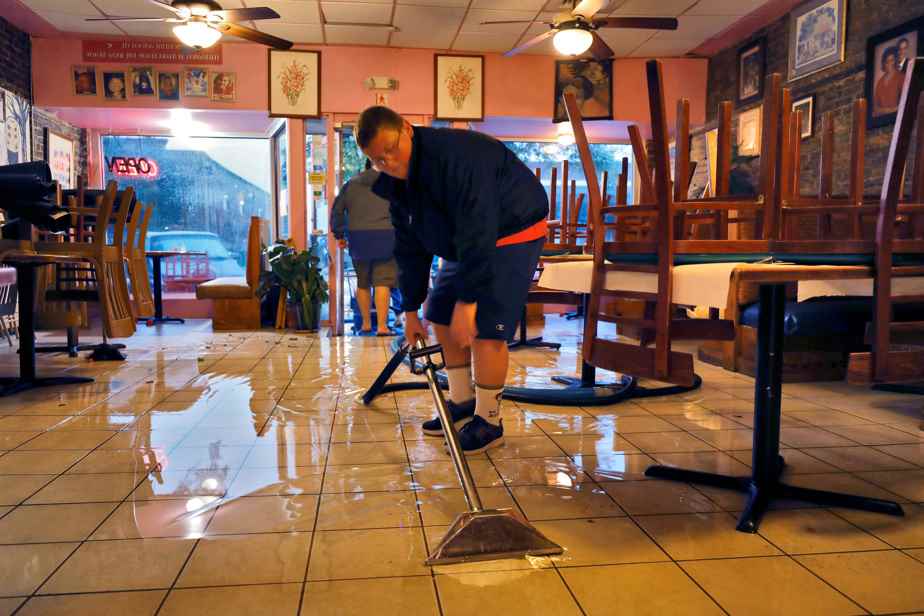(Fort Myers) The Storm Ian continues to weaken in the southeastern United States on Saturday and is expected to dissipate overnight, after causing flooding in South Carolina and devastating large swathes of Florida, where it caused several dozen of victims.
Posted at 7:39
The authorities of this State confirmed Friday evening a new toll of 23 victims, most of them by drowning and in their vast majority of the elderly.
Some American media evoke an even heavier human toll, the CNN television channel evoking 45 deaths.
After ravaging Florida, Ian tracked into South Carolina, where it made landfall Friday afternoon near Georgetown as a Category 1 hurricane, accompanied by winds of up to 140 km/h, according to the National Hurricane Center (NHC) based in Miami.

PHOTO JONATHAN DRAKE, REUTERS
Pumps have been installed to evacuate accumulated water from businesses in Georgetown, North Carolina.
It then weakened into a post-tropical storm. On Saturday morning, its winds were only blowing at about 50 km / h when it crossed North Carolina, noted the NHC.
Although the risk of heavy rains and “moderate” flooding remains in the central Appalachian and northeastern United States, Ian “expected to dissipate over south-central Virginia” overnight Saturday, the center predicted.
President Joe Biden has urged residents to heed calls for caution from local officials. In South Carolina, they had notably urged the population not to drive on the roads invaded by water.
“It’s a dangerous storm that will bring high winds and lots of water, but the most dangerous thing will be human error. Be smart, make good decisions, check in on loved ones and stay safe,” Governor Henry McMaster tweeted.
Some 575,000 homes and businesses were already without power Friday evening in South Carolina, North Carolina and Virginia, according to the specialized site PowerOutage.
“Historic” damage in Florida
In Florida, in addition to the heavy human toll, the material damage is “historic”, the level reached by the rising waters having been unprecedented, according to Governor Ron DeSantis.
Streets and homes were flooded and boats moored in marinas were tossed onto land by the storm. On Friday, in Kissimmee, not far from Orlando, the authorities crossed the flooded areas in boats to rescue residents trapped in their homes.

PHOTO RICARDO ARDUENGO, AGENCE FRANCE-PRESSE
The only road leading to the Matlacha neighborhood of Fort Myers, Florida was damaged during the passage ofIan.
In this state, “we are just beginning to see the extent of the destruction”, “likely to rank among the worst” in the history of the United States, said Joe Biden during a speech.
“It will take months, years to rebuild,” he lamented.
Friday evening, more than 1.4 million customers remained without electricity two days after the passage ofIanaccording to PowerOutage.
Terraces
In the coastal town of Fort Myers, called the “epicenter” by Ron DeSantis, a handful of restaurants and bars had reopened and dozens of people were seated on terraces, offering residents a semblance of normalcy between broken trees and destroyed facades.

PHOTO GIORGIO VIERA, AGENCE FRANCE-PRESSE
View of a mobile home park in Fort Myers
“It was pretty terrible, but we held on. The roof of our house was blown off, a big tree collapsed on top of our cars, our garden was flooded, but other than that it’s fine,” says Dylan Gamber, 23, welcoming the solidarity that reigned among neighbours.
According to initial estimates, the passage of the hurricane Ian could cost insurers tens of billions of dollars and will weigh on American growth, in particular due to flight cancellations and damage to agricultural production.
At the same time, the search continued to find 17 passengers of a migrant boat which capsized on Wednesday near the archipelago of the Keys.
According to a first rapid study by American scientists made public on Friday, the rains linked to the hurricane Ian have been increased by at least 10% due to climate change.
“Climate change didn’t cause the hurricane, but it did make it wetter,” said Michael Wehner of the US Department of Energy’s Lawrence Berkeley National Laboratory, one of the scientists involved in the this study.
Before Florida, Ian hit Cuba, causing three deaths and extensive damage and leaving many homes without electricity.
